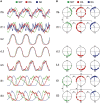Multiple monoaminergic modulation of posturo-locomotor network activity in the newborn rat spinal cord
- PMID: 25177275
- PMCID: PMC4133733
- DOI: 10.3389/fncir.2014.00099
Multiple monoaminergic modulation of posturo-locomotor network activity in the newborn rat spinal cord
Abstract
Studies devoted to understanding locomotor control have mainly addressed the functioning of the neural circuits controlling leg movements and relatively little is known of the operation of networks that activate trunk muscles in coordination with limb movements. The aim of the present work was (1) to identify the exogenous neurotransmitter cocktail that most strongly activates postural thoracic circuitry; (2) to investigate how the biogenic amines serotonin (5-HT), dopamine (DA), and noradrenaline (NA) modulate the coordination between limb and axial motor networks. Experiments were carried out on in vitro isolated spinal cord preparations from newborn rats. We recorded from ventral roots to monitor hindlimb locomotor and axial postural network activity. Each combination of the three amines with excitatory amino acids (EAAs) elicited coordinated rhythmic motor activity at all segmental levels with specific characteristics. The variability in cycle period was similar with 5-HT and DA while it was significantly higher with NA. DA elicited motor bursts of smaller amplitude in thoracic segments compared to 5-HT and NA, while both DA and NA elicited motor bursts of higher amplitude than 5-HT in the lumbar and sacral segments. The amines modulated the phase relationships of bursts in various segments with respect to the reference lumbar segment. At the thoracic level there was a phase lag between all recorded segments in the presence of 5-HT, while DA and NA elicited synchronous bursting. At the sacral level, 5-HT and DA induced an intersegmental phase shift while relationships became phase-locked with NA. Various combinations of EAAs with two or even all three amines elicited rhythmic motor output that was more variable than with one amine alone. Our results provide new data on the coordinating processes between spinal cord networks, demonstrating that each amine has a characteristic "signature" regarding its specific effect on intersegmental phase relationships.
Keywords: dopamine; locomotion; neuromodulation; noradrenaline; posture; serotonin; spinal cord.
Figures




References
Publication types
MeSH terms
Substances
LinkOut - more resources
Full Text Sources
Other Literature Sources

